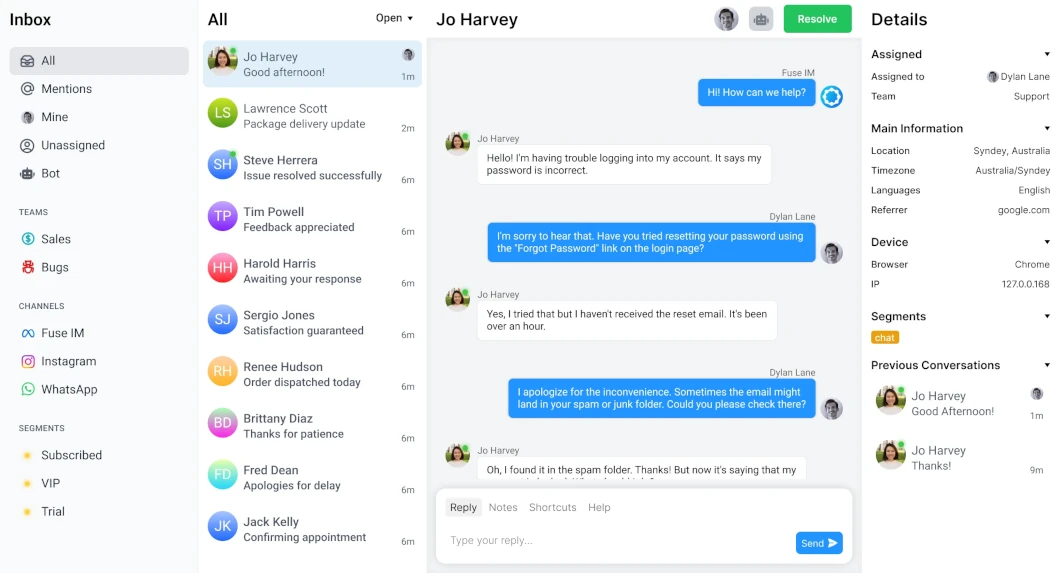You’ll have heard a lot about chatbots in recent months, and with good reason — they’re a game changer when it comes to communication, allowing businesses to streamline their internal and external communication. In short: they’re becoming an essential part of the modern business world, and they’re very much here to stay.
You’ll often hear people talking about chatbots as if they were a single product. In reality, there are many types of chatbots, and since this is an innovative and quickly evolving industry, it’s likely that there’ll be many more in the years to come.
Different chatbots serve different needs. Some exist to manage the customer experience; others function as de facto personal assistants. Most businesses deploy a variety of chatbots as part of their operations.
In this post, we’re going to take a closer look at the different types of chatbots currently available on the market. Not all of the chatbots we outline will be relevant to your needs, but there’ll likely be at least a couple that are — and once you’ve integrated them into your business, you’ll find that your communication is more straightforward, productive, and effective than ever before.
AI-powered bots
AI-powered bots are the best-in-class chatbots on the market. They use the latest, best technology, and if you’ve interacted with an impressive chatbot recently, you can be pretty confident that it was an AI-powered bot.
So what makes AI-powered bots so good? It’s all down to the technology that underpins the tool. Built with machine learning and natural language processing processes, AI-powered chatbots can interact with users in a dynamic, human-like manner. They’re better able to understand user intent than other chatbots, which makes them better equipped to deliver an appropriate response. They also “sound” human-like, and are capable of having fluid back-and-forth conversations with the user, providing a natural and positive experience.
AI-powered bots can be trained to do any number of tasks, and thanks to their machine-learning capabilities, they get better over time. They’re highly dependable, capable of running 24 hours a day, seven days a week, and can be tweaked to the company’s individual branding, allowing for a consistent brand voice.
Some of the key benefits of AI-powered bots include:
Customers Get Faster Responses
Customers would prefer not to have questions, but when they do, they want the answer as quickly as possible. AI-powered bots provide instant answers to customer queries, even when the query is complex. There’ll be some instances where a human customer service representative has to step in, but AI-powered bots can handle a huge chunk of customer queries with ease.
Saves Employee Time
Your employee’s time is important. The company — and the employees — would rather that staff spend their time engaging in value-adding tasks, rather than answer routine questions. And the truth is that most customer questions are routine, not complex. AI-powered bots can field those run-of-the-mill queries, allowing your staff to focus on more beneficial tasks.
Omnichannel Support
Customers have their own preferences about how they reach out to a company. Some will do so directly on the company’s website. Others will use Facebook Messenger or another social media channel. Once configured, AI-powered chatbots can be deployed across various channels, ensuring that customers can get their questions answered wherever they are, and that brand voice is consistent regardless of the platform.
Virtual assistants
You’ll often hear about chatbots discussed in terms of how they can enhance the customer’s experience. But there are “behind the scenes” uses of chatbots, too.
Virtual assistants can perform a wide variety of everyday tasks, in much the same way that a real, live assistant would. While this might sound pretty fancy, virtual assistants are a lot more common than you might think — in fact, you’ve probably already got access to a virtual assistant. Google Assistant, Apple’s Siri, and Amazon Alexa are all virtual assistants.
Whereas chatbots elevate a company’s customer support, virtual assistants can help elevate a company’s business operations. They’re there to help users take care of everyday tasks, such as setting alarms, creating appointment reminders, sending text messages, and making phone calls.
You’ll interact with a virtual assistant in a similar way to how you’d interact with a chatbot, but there are some key differences. One is how virtual assistants are integrated. Whereas chatbots are deployed on websites, social media sites, apps, and other public-facing arenas, virtual assistant technology is built into the program being used.
It’s also possible for virtual assistants to assist in the customer’s experience, in some industries at least. For example, clothes stores may deploy software that provides customers with their own style assistant based on virtual assistant technology.
Rule-based chatbots

Rule-based chatbots have been around for a while, and you’ll still find them used on many websites despite the emergence of AI-powered bots. These chatbots are still automated and effective, but they’re based on older technology than other chatbots and therefore can be viewed as more limited. But when they work, they work well.
Rule-based chatbots follow existing rules that have been pre-programmed. For example, if a customer asks ‘x,’ the rule-based chatbot will respond with ‘y.’ This is an effective way to communicate commonly-asked questions, such as “What are your opening hours?” or “How long does delivery take?” but it can fall down when it comes to more complex questions that go beyond the scope of the bot’s pre-programmed script.
They’re popular with small- to medium-sized businesses that don’t require AI-powered bots, or which only ever receive straightforward questions. In this scenario, rule-based chatbots can be highly effective and help lighten workload.
The downside is that, since they’re not built using machine learning technology, they don’t improve over time. Rule-based chatbots can’t decode more complex language; in fact, they can’t decode anything, since the only replies they can offer are dependent on existing inputs. Rule-based chatbots are useful, but companies looking for forward-thinking solutions will be better served by AI-powered chatbots.
Voice-enabled chatbots
For voice-enabled chatbots, the giveaway is the name. Unlike most types of chatbots available, which are text-based, voice-enabled chatbots rely on voice — they can decode the user’s vocal input and then verbalize the answer. This allows for more natural interaction, and it’s something that customers are warming to: some 70% of consumers have said they enjoy using voice-enabled chatbots over text-input chatbots, though it’s important to note that this only applies to certain devices and types of query.
Voice-enabled chatbots work best in scenarios where people aren’t able to type. For example, while they’re driving, cooking, or multitasking. In fact, you’ll probably have used voice-enabled chatbots when you were doing one of those things — Google Assistant, Alexa, and Siri are all voice-enabled chatbots.
There’s a wide range of applications for this type of chatbot. And they can certainly come with a host of advantages. Some of the key benefits of voice-enabled chatbots include:
Accessibility
Offering voice-enabled chatbots can increase accessibility and inclusivity. They’re particularly good for physically impaired individuals or those with reduced vision. As such, they can improve the range of customers who can interact with a company’s digital services.
Improved User Experience
It’s not always possible to type out a query. When customers cannot type, such as when they’re driving or otherwise using their hands, voice-enabled chatbots ensure that they can still get the information they need.
They Recreate A Customer Service Team
It’s recommended to have live customer service representatives, but some businesses can’t afford to hire a full-time team. With voice-enabled chatbots, budget-conscious businesses can get a round-the-clock customer service team that can answer frequently asked questions.
Customer service bots
Customer service bots help businesses to effortlessly and efficiently interact with their customers. The technology that customer service bots are built on can vary and is mostly dependent on the organization’s needs. For example, the customer service bot may be built on artificial intelligence or use the rule-based scripts we outlined above.
More and more, companies are turning to AI-powered customer service bots, which offer a wide range of benefits to both the organization and the customer.
Modern customer service bots can provide support in a large number of languages, ensuring that the customer can get the help they need in their preferred language. These bots are also highly capable, and can detect a customer’s query — and offer an appropriate response — without any human intervention, in real-time.
The advantages to the business are manifold. For one thing, customer service bots are capable of delivering a high level of customer service, which helps improve customer retention. Additionally, they can also be programmed to offer personalized results and special offers, which can improve AOV. The data provided by customer service bots can also help to drive strategic decisions — you’ll learn a lot about who your customers are and what they want thanks to the analytics provided.
Social media chatbots
There’s more than one way to use chatbots. Many companies are already using these advanced customer service tools to enhance customer communication on their websites. Increasingly, brands are deploying the technology across various social media platforms, too.
You can integrate chatbots on Facebook, Instagram, WhatsApp, and other social media websites, and there’s a good reason why you should — it’s where your customers are. There are more than 4.5 billion social media users across the world, and a whopping 80% of consumers have contacted a business through its social media websites.
As such, while a company’s social media channels would always play second fiddle to its primary website, from a customer service perspective, social media should be viewed just as importantly. By using a social media chatbot, companies can free up their time, provide customers with immediate responses, and help push their customers along the customer journey.
It’s easy to overlook social media messages, but those customers are just as important as the ones on your website. By implementing social media chatbots, businesses can provide a consistent experience regardless of which digital touchpoint the customer interacts with your business, improve engagement, gather feedback, and more.
E-commerce chatbots
E-commerce chatbots are simply chatbots that have been tailored to enhance the customer’s e-commerce experience. There are different types of e-commerce chatbots, including AI-powered chatbots, rules-based chatbots, and hybrid chatbots that use both technologies.
They can provide a wide range of tasks, from answering questions, providing product advice, offering personalized recommendations, and reducing shopping cart abandonment. In truth, e-commerce chatbots are almost as capable as live agents, while also managing to be available 24/7 and help multiple customers at one time.
Studies have shown that e-commerce chatbots can boost sales by nearly 70% and have a positive impact on shopping cart abandonment rates. While popular for communicating with all shopper demographics, e-commerce chatbots have been shown to be particularly popular with Gen Z and Millennial consumers.
Personal assistant bots
Personal assistant bots help businesses become more productive, streamline repetitive tasks, save money, and more. They’re somewhat similar to virtual assistant bots in terms of what tasks they can do too, but whereas virtual assistants offer general support, personal assistant bots are designed to handle specific tasks.
You’d use a virtual assistant when you wanted an answer to a question; a personal assistant bot is there to automate everyday or repetitive tasks. They can help teams to become more cohesive by strengthening the underlying operations of a business. For example, a personal assistant bot can send automatic emails, make travel arrangements, schedule appointments, or automatically approve/deny expense claims.
The ins and outs of what a personal assistant bot can do depends on the organization. But the bottom line is that they help to free up employees’ time, allowing them to focus on value-adding tasks rather than repetitive tasks.
Conclusion
As we’ve seen, there’s a whole host of different types of chatbots on the market, and there’ll likely be many more in the years to come, too. Forward-thinking companies can get ahead of the competition and improve their operations by incorporating the appropriate chatbots today. To get started with AI-powered customer service, check out Fuse IM.


